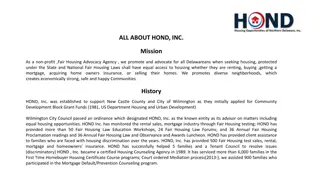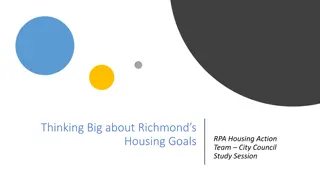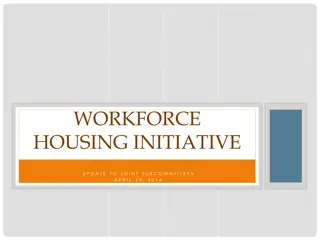Understanding the Importance of Housing in Home Management
Housing plays a vital role in meeting the basic needs of individuals and families by providing shelter, security, and a sense of belonging. It serves as a physical structure for living, fosters family relationships, and contributes to personal development and societal progress. Different types of residential buildings cater to diverse housing needs, from detached houses to skyscrapers, reflecting varying lifestyles and economic factors.
Download Presentation

Please find below an Image/Link to download the presentation.
The content on the website is provided AS IS for your information and personal use only. It may not be sold, licensed, or shared on other websites without obtaining consent from the author. Download presentation by click this link. If you encounter any issues during the download, it is possible that the publisher has removed the file from their server.
E N D
Presentation Transcript
TOPIC HOME MANAGEMENT BA PART II HONS., 2ndPAPER Dr. AMARJEET KUMAR ASST. PROFESSOR DEPARTMENT OF HOME SCIENCE ROHTAS MAHILA COLLEGE,SASARAM
Introduction: HOUSING: The house is the first unit of society and it is the primary unit of human habitation. The housing, next to food and clothing, satisfies one of the basic needs of man. According to National Building Organization a house is a pucca or semi-pucca unit of dwelling that can accommodate an average household with advancement in science and technology man has created newer designs of shelter to provide greater comfort, convenience and facilities.
Importance of House: 1. A house is a physical structure consisting of walls, doors, windows, roofs, etc. in which human being live and seek refuge from tensions and worries of the outside world. 2. The house protects the family members from excessive cold and heat, wind and rain and from all external anti-social elements. 3. The house forms the center of family life. It is a place where family members are bound together by love and affection and enjoy group living. 4. The house provides space for group and individual activities for the members of the family such as cooking, serving, washing, storage, disposal of waste, recreation, reading and hospitality. 5. The house offers facilities for self-expression and a degree of freedom of action. 6. A good house provides a healthy environment for its members to develop their personality, attitudes, values and a sense of security in addition to rest and privacy.
Importance of House: 7. Only in the house an individual acquires customs, traditions, habits and culture of the family. 8. A house is the place where some family members who cannot support themselves for reasons of sickness, unemployment, old age, widow-hood or other handicaps get shelter and care. 9. A house and its surrounding is a status symbol of a family. 10. Housing is the determining factor for the standard of living of a family. 11. The housing condition is a measure of nation s progress. 12. Housing contributes to national income, national wealth and national employment.
The residential buildings may broadly be classified into five categories as follows 1. Detached house: This is an independent house surrounded by its own land on all the sides. 2. Semi-detached house: A common boundary wall to form a structural barrier and divides an independent plot into two units. This helps in achieving economy by sharing expenses on amenities such as water lines, drainage lines, electric cables etc. 3. Row of houses: This is preferred for low-income group of families. These rows of houses, having a common wall between two houses, with minimum requirements such as living room, and kitchen. 4. Apartments or flats: This consists of three to seven storeys and each floor or storey may accommodate two or four tenements. The land and other amenities are shared by all the occupants. 5. Skyscrapers: These are multi-storeyed building. This is common in big cities where the price of the land is very high.
Factors affecting choice of house The following points should be kept in mind while looking out for a house. 1. Physiological needs : The house should have adequate ventilation and proper orientation so that there is proper temperature balance, adequate fresh air circulation and light. 2. Psychological needs : The house should provide privacy and safety. 3. Family size : A large family with more than six members have to go for a larger house than a small family with four members. 4. Family type : Families can be classified as nuclear, extended or joint families. The size of the house will vary according to the type of family. 5. Stage of family life cycle : The stage in which the family is, should be considered. A family in the expanding stage will need a larger house than a family in the beginning or contracting stage. 6. Family Structure : This indicates the build up of the family with regard to the age, sex and their relationship of one member to another.
7. Family Values and Standards : The standard of living that a family wants to maintain, the family values and priorities in life should be considered while selecting a house. 8. Permanence of residence : There are two types of family in this regard. Transient family - which has to move from place to place, because of occupational or other needs. 1. 2. A Permanent family - which is reasonably sure of staying in the same place for a long time.This factor should be considered while making decision to rent or own a house. 9. Cost of living: The cost of living in a particular area should be taken into account while deciding on the locality of the house. 10. Cost of building: The financial status of the family should be considered while selecting a house
Owning or renting a house Owning : This is buying a house outright in order to secure it services. Advantages of owning 1) People who own a house will feel secure and have a feeling of belongingness. 2) Can stay in a house for a long period. 3) Become a means of compulsory saving. 4) Changes or improvement in the house can be made whenever needed. 5) Gives a feeling of happiness, pride and sense of security during old age . 6) Credit can be acquired easily. 7) Can develop longstanding friendship with neighbors. 8) It is a good investment. 9) Have tax benefits. 10) Better furniture and furnishing can be purchased.
Renting: Renting is the compensation that is paid to the owner, generally in terms of money, by the user for the services of a house, from month to month. Advantages of Renting 1. Freedom of mobility. 2. Can take advantage of different occupational opportunities. 3. Can change the house according to the needs and income of the family. 4. No responsibility of maintaining the property. 5. No need to invest on furnishings and furniture as furnished house can be rented. 6. Renting is cheaper. 7. Higher living standards can be achieved. 8. The family will not get affected if the property value decreases. 9. Money spent on buying the house can be invested in other business to get more money returns. 10. Gives financial freedom. In general, many families feel that owning a house is far better than renting.
SiteSelection Each family attempts to meet its housing needs through the selection of a dwelling unit. The house is probably the largest single investment you will make in your life. One cannot change one s residence often. Hence it becomes essential for each one of us to have adequate knowledge about selection of a site and house planning. A site in a good locality should be selected. Now let us see the factors to be considered while selecting a site for the construction of a house
i. Physical Features 1. The site should be regular in shape and should have exact boundaries marked on the land. 2. A low lying ground is unhealthy because it is likely to cause dampness during rainy season and it becomes a breeding place for flies and mosquitoes. 3. The site should be on an elevated ground for drainage of water especially during rainy season. 4. A site on an elevated ground affords wider and brighter view of the house. 5. Site which faces South/North direction is preferable.
ii. Soil Conditions 1. The best soil is one where soft soil is at the surface and hard soil beneath 3 or 4 ft. 2. A mixture of sand and gravel is good. 3. Rocky surfaces afford good foundation, but poses difficulty while leveling or excavating the ground due to its hardness. On rocky surface, laying drainage pipe is very costly. Besides, it is not suitable for growing plants. 4. Clay and sandy soils are unsuitable because clay surface holds water for a long time and sandy soil absorbs water.
iii. Sanitary Facilities 1. There should be no stagnant pools or water tanks and unused wells around the site. 2. The site should never be surrounded by public drainage and toilet. 3. The site should not be selected near cattle sheds, poultry farm and factories for health reasons. 4. Reclaimed land filled with debris and refuse is unhealthy for building purposes, as it will give out obnoxious gases. During rainy season it becomes a good breeding place for flies and mosquitoes. 5. The site should be such as to command fresh air, ample lighting and good water supply. 6. A site in a busy locality may not be suitable for health reasons because of dust and the constant smoke from vehicles. 7. A site with modern sanitary facilities is the most suitable.
iv. Practical Convenience The value of the site depends upon the convenience available around. The site should be within easy reach to school, market, bank, hospital or nursing home, railway station, bus terminus and post office. v. Good Neighborhood 1. The site should be selected near a developed area for safety. 2. Good neighborhood adds to the permanent happiness of the family. 3. The economic and social status of the neighborhood should be on par with the occupants. 4. The area should be pleasant and charming. 5. The site in the neighborhood of a sea commands pleasant sea breeze. But one disadvantage is that sea breeze carries with it a thin spray of salty water, which corrodes all iron articles.
vi. Legal Characteristics 1. The legal description of the plot and the exact location of the plot must be known. 2. The site should be a freehold land without encumbrance. 3. A legal advisor should be consulted, the place surveyed and the boundaries marked on.























